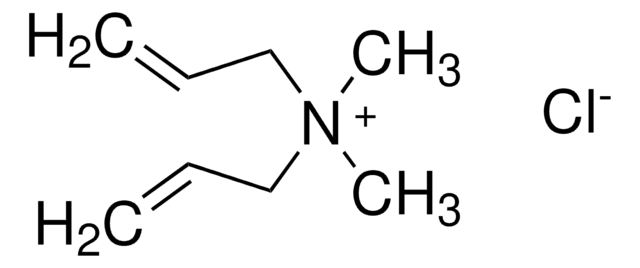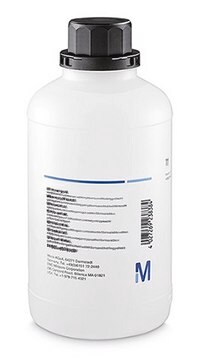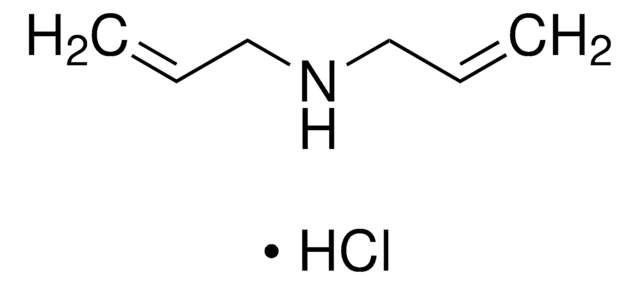32598
Diallyldimethylammonium chloride
≥97.0% (AT)
Sinónimos:
DADMAC, Dimethyldiallylammonium chloride, N,N-Diallyl-N,N-dimethylammonium chloride
Iniciar sesiónpara Ver la Fijación de precios por contrato y de la organización
About This Item
Fórmula lineal:
(CH2=CHCH2)2N(Cl)(CH3)2
Número de CAS:
Peso molecular:
161.67
Beilstein:
5830817
Número CE:
Número MDL:
Código UNSPSC:
12162002
ID de la sustancia en PubChem:
NACRES:
NA.23
Productos recomendados
Ensayo
≥97.0% (AT)
Formulario
solid
mp
140-148 °C
cadena SMILES
[Cl-].C[N+](C)(CC=C)CC=C
InChI
1S/C8H16N.ClH/c1-5-7-9(3,4)8-6-2;/h5-6H,1-2,7-8H2,3-4H3;1H/q+1;/p-1
Clave InChI
GQOKIYDTHHZSCJ-UHFFFAOYSA-M
Descripción general
Diallyldimethylammonium chloride (DADMAC) is a quaternary ammonium compound available in solid form with an assay of ≥97.0%. It serves as a versatile monomer in various polymerization processes and is primarily used in the production of cationic polymers. These polymers are essential in a range of applications, particularly in the fields of water treatment, paper production, and personal care products. Additionally, DADMAC exhibits antifouling properties, making it valuable for applications where the prevention of biofilm formation and surface fouling is critical.
Aplicación
Diallyldimethylammonium chloride can be used as:
- A precursor for the synthesis of poly(diallyldimethylammonium chloride) (PDADMAC), which is widely used in various applications related to water purification and wastewater management.
- a monomer in the synthesis of cationic hydrogels via radical polymerization. The resulting polymer, poly(diallyldimethylammonium chloride) (PDADMAC), features a high cationic charge density, which is crucial for effectively binding anionic dyes. This property makes PDADMAC-based hydrogels valuable materials for wastewater treatment applications.
- DADMAC has been used in dental biomaterials to enhance their antifouling properties. When incorporated into acrylic resins, it provides effective antibacterial and antifungal activity without compromising biocompatibility
Código de clase de almacenamiento
11 - Combustible Solids
Clase de riesgo para el agua (WGK)
WGK 1
Punto de inflamabilidad (°F)
Not applicable
Punto de inflamabilidad (°C)
Not applicable
Equipo de protección personal
dust mask type N95 (US), Eyeshields, Gloves
Elija entre una de las versiones más recientes:
¿Ya tiene este producto?
Encuentre la documentación para los productos que ha comprado recientemente en la Biblioteca de documentos.
Los clientes también vieron
Yuanyuan Zhang et al.
ACS nano, 9(7), 7124-7132 (2015-07-15)
In this study, we demonstrate multilevel and multicomponent layer-by-layer (LbL) assembly as a convenient and generally applicable method for the fabrication of nanofibrillar films by exploiting the dynamic nature of polymeric complexes. The alternate deposition of poly(allylamine hydrochloride)-methyl red (PAH-MR)
Deyi Zhu et al.
Journal of industrial microbiology & biotechnology, 42(2), 189-196 (2014-12-30)
Collagen fiber (CF), an abundant natural biopolymer, features many favorable properties that make it a potential carrier for cell immobilization. In the present investigation, CF was grafted with polyethyleneimine (PEI) using glutaraldehyde (GA) as the cross-linking agent, resulting in the
Zhenxi Zhang et al.
Journal of biomedical optics, 20(5), 51043-51043 (2015-05-30)
There are three possible mechanisms for 5-aminolevulinic acid (5-ALA) conjugated gold nanoparticles (GNPs) through electrostatic bonding for photodynamic therapy (PDT) of cancer: GNPs delivery function,singlet oxygen generation (SOG) by GNPs irradiated by light, and surface resonance enhancement (SRE) of SOG.
Ya Xiong et al.
Talanta, 129, 282-289 (2014-08-17)
Simple, rapid and sensitive analysis of thrombin (a tumor biomarker) in complex samples is quite clinical relevant and essential for the development of disease diagnosis and pharmacotherapy. Herein, we developed a novel method based on aptamer-conjugated magnetic graphene/gold nanoparticles nanocomposites
Feng Gu et al.
Journal of chromatography. A, 1376, 53-63 (2014-12-30)
The main objective of our research was to develop silica-based, polymer-functionalized ion exchange materials for single-use bioprocess applications, with the ultimate goal of achieving maximal binding capacity for target proteins. Herein we report the utilization of Grace(®) wide pore silica
Nuestro equipo de científicos tiene experiencia en todas las áreas de investigación: Ciencias de la vida, Ciencia de los materiales, Síntesis química, Cromatografía, Analítica y muchas otras.
Póngase en contacto con el Servicio técnico


![[2-(Methacryloyloxy)ethyl]trimethylammonium chloride solution 75 wt. % in H2O](/deepweb/assets/sigmaaldrich/product/structures/316/612/66b0f4cf-d060-427d-b4f5-e8fab3e5cffe/640/66b0f4cf-d060-427d-b4f5-e8fab3e5cffe.png)

![[2-(Acryloyloxy)ethyl]trimethylammonium chloride solution 80 wt. % in H2O, contains 600 ppm monomethyl ether hydroquinone as inhibitor](/deepweb/assets/sigmaaldrich/product/structures/393/326/f7e19585-5431-4220-81b5-f458de6d63d0/640/f7e19585-5431-4220-81b5-f458de6d63d0.png)




